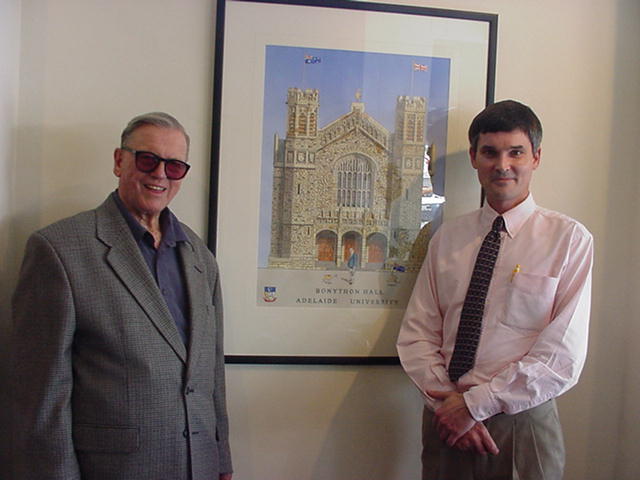
Kym Bonython and Bonython Hall - University of Adelaide
Kym Bonython was a prominent and active member of society in Adelaide, Australia. He had a distinguished career as a pilot during the Second World War, was a jazz drummer, owned an art gallery, raced speedcars, and served on the Adelaide City Council 1.
Bonython was born on September 15, 1920 in Adelaide, South Australia. He was the youngest child of Sir John Lavington Bonython and his second wife Lady Jean Bonython 1. He attended St Peter’s College, Adelaide, and upon completion entered into accountancy on the recommendation of his older half-brother John. However, the Second World War interrupted this: in 1940 he began training as a pilot for the Royal Australian Air Force (RAAF) 1. During his time with the RAAF, Bonython filled the roles of aircraft captain in 1941, and chief flying instructor with the rank of squadron leader in 1943. On September 1, 1944, Flight Lieutenant Bonython (Aus.280778) was awarded the Air Force Cross (AFC), and on February 22, 1946, Squadron Leader Bonython AFC was awarded the Distinguished Flying Cross (DFC) 1.
After returning from service, Bonython chose not to return to accounting and instead took up dairy farming on his father’s Mount Pleasant property. In the 1950s his career changed to incorporate music, the arts, and motor racing. As a child Bonython developed a passion for jazz and this influenced a number of his later pursuits. At the age of 17, in 1937, he entered the media with an ABC radio jazz show. The show continued for 38 years, finishing in 1975. His involvement in the jazz scene also extended to making and selling music; in 1952 he became a member of a jazz band as drummer – a skill he had learned as a child – and he opened his first record store in Bowman’s Arcade on King William Street in 1954 1.
Bonython was also an art collector and owned an art gallery called “Kym Bonython’s Gallery” which was located on North Terrace in Adelaide. The gallery was known for its exhibitions of contemporary Australian art 1. In addition to these pursuits, Bonython also raced speedcars and served on the Adelaide City Council 1.
In conclusion, Kym Bonython was an accomplished individual who excelled in many fields throughout his life. From his distinguished career as a pilot during World War II to his involvement in jazz music and art collecting later in life, Bonython left an indelible mark on Australian society.
Bonython Hall: The Academic Jewel of the University of Adelaide. Nestled in the heart of Adelaide, South Australia, the University of Adelaide boasts a rich history and a strong commitment to academic excellence. At the heart of this venerable institution lies Bonython Hall, an architectural masterpiece and a symbol of the university's dedication to scholarship and cultural enrichment. Bonython Hall stands as a testament to the university's enduring legacy and its unwavering pursuit of knowledge.
Bonython Hall, completed in 1936, is a magnificent example of neoclassical architecture. Named after Sir John Langdon Bonython, a notable South Australian philanthropist, journalist, and university supporter, the hall was designed by the renowned architect Walter Hervey Bagot. Its imposing Corinthian columns, grand portico, and majestic dome make it a breathtaking sight. The hall's interior is equally impressive, featuring an awe-inspiring organ, intricate stained glass windows, and a beautiful vaulted ceiling that showcases the grandeur of classical architecture. This splendid structure serves not only as a venue for graduations, lectures, and concerts but also as a symbol of the university's commitment to the pursuit of knowledge.
Bonython Hall's significance goes beyond its architectural beauty. It has played a central role in the cultural and academic life of the university and the wider community. Graduation ceremonies held at Bonython Hall are a rite of passage for thousands of students, marking the culmination of their academic journeys and the beginning of new chapters in their lives. The hall's association with these milestone events fosters a sense of tradition and pride among students, faculty, and alumni.
Furthermore, Bonython Hall serves as a hub for cultural enrichment. It hosts various cultural events and musical performances throughout the year, providing a platform for students and the wider community to celebrate the arts and showcase their talents. The iconic organ, built by renowned firm J.E. Dodd & Sons, is a prominent feature in these musical events, adding a rich auditory dimension to the hall's cultural significance.
Bonython Hall is not merely a relic of the past; it continues to be a vibrant and functional space for learning and cultural enrichment. Its enduring appeal and historical significance make it a beloved and cherished part of the University of Adelaide. Students, faculty, and visitors alike are drawn to its splendor and the sense of tradition it embodies.
In conclusion, Bonython Hall stands as a symbol of the University of Adelaide's unwavering commitment to academic excellence, cultural enrichment, and tradition. Its neoclassical architecture, rich history, and central role in the university's communal life make it a true academic jewel. Bonython Hall's legacy continues to inspire and unite the university community and the wider public, reinforcing the enduring importance of higher education and cultural enrichment in the heart of Adelaide.